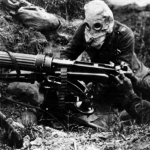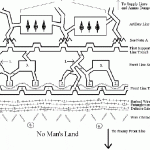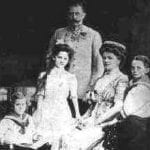The British developed the tank in response to the trench warfare of World War I. In 1914, a British army colonel named Ernest Swinton and William Hankey, secretary of the Committee for Imperial Defense, championed the idea of an armored vehicle with conveyor-belt-like tracks over its wheels that could break through enemy lines and traverse difficult territory. The men appealed to British navy minister Winston Churchill, who believed in the concept of a “land boat” and organized a Landships Committee to begin developing a prototype. It all came together at the Battle of Cambrai in 1917. The British saw it as their greatest victory. Church bells tolled throughout great Britain, the first time this had happened in the entire war.
- The Eastern Front, November 1916 – November 1917
- In November, 1916, Emperor Franz Joseph died and was replaced by Karl.
- Emperor Karl removed Conrad von Hotzendorf as Chief of Staff and replaced him with Arthur von Straussenburg.
- In March, Karl put out peace feelers to the Allies. Nothing came of them.
- On July 1, a Russian force of 200,000 led by Alexi Brusilov began an offensive aimed at Lemberg. The Russians initially pushed the Austrians back several miles and took thousands of prisoners. By the 13th, the Russians were approaching the Hungarian border. (The offensive is usually called the “Karensky Offensive” after Russian Minister of War Alexander Karensky, who went to the field to provide support).
- On July 19, German and Austrian forces counterattacked, pushing back the Russians, capturing 6000 prisoners, and causing a rift in the Russian lines. By the end of July, the Russians had begun fleeing. Many deserted.
- On August 1, Karensky replaced Brusilov with Lev Kornilov as Russian commander in chief in the east.
- On September 1, German forces began bombarding Riga. The Russian garrison fell back. The Germans captured the city.
- In October, the Germans began an amphibious assault called Operation Albion. By the end of the month, they had captured the islands off the Baltic coast and then landed on the Russian mainland and were threatening Petrograd.
- In November 1917, the Russian-German front went silent. Germany began transferring 500,000 men from the east to the west.
-
Cambrai: Initial Attack
-
The battle began at 6 AM on November 20 with a preliminary barrage of 1000 guns and 6 infantry divisions of the British third army supported by 9 tank corps. There were 476 total tanks, with 378 total fighting tanks.
-
There were also 300 supporting aircraft.
-
The tanks broke through the Hindenburg line, up to 6 miles deep. But by then 180 tanks were already out of actions. One German soldier is believed to have taken out 7 tanks himself.
-
The next day, a fresh German division was rushed into place. They halted the British advance.
-
Nevertheless, the British saw it as their greatest victory of the war. Church bells tolled throughout great Britain, the first time this had happened in the entire war.
-
-
German Counterattack
-
At Bourlon Wood, the Germans counterattacked and pushed the British back. They also recovered 100 captured guns.
-
The next day, the British dug in a salient.
-
November 30: The Germans attacked swiftly, taking large casualties and gaining ground. But they were stopped by British tanks.
-
December 3: The Germans captured La Vacquerie. Nearly all British gains had been erased. Gas was lingering everywhere.
-
- Results
- Total casualties were about 40,000 on each side. Around 9000 British and 11,000 German prisoners were taken.
- Both sides learned that tanks, properly deployed, could have a big effect on battle, particularly with breaking through barbed wire.
- Germany showed the effectiveness of combining stormtroop attacks, gas, artillery, and trench mortars
- The London Times later called the battle “One of the most ghastly stories in English history.”
Cite This Article
"Battle of Cambrai" History on the Net© 2000-2024, Salem Media.
April 24, 2024 <https://www.historyonthenet.com/battle-of-cambrai-2>
More Citation Information.









